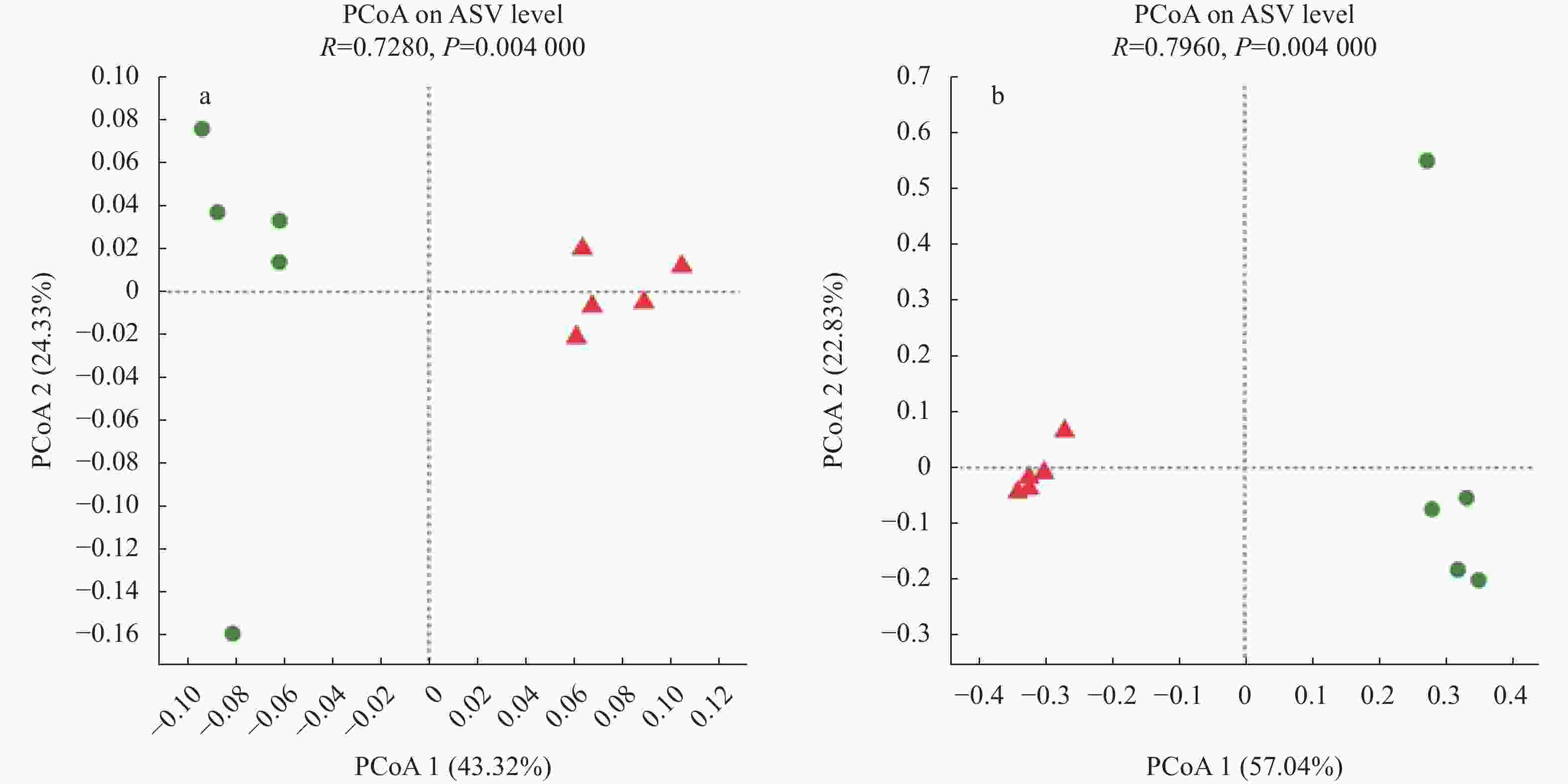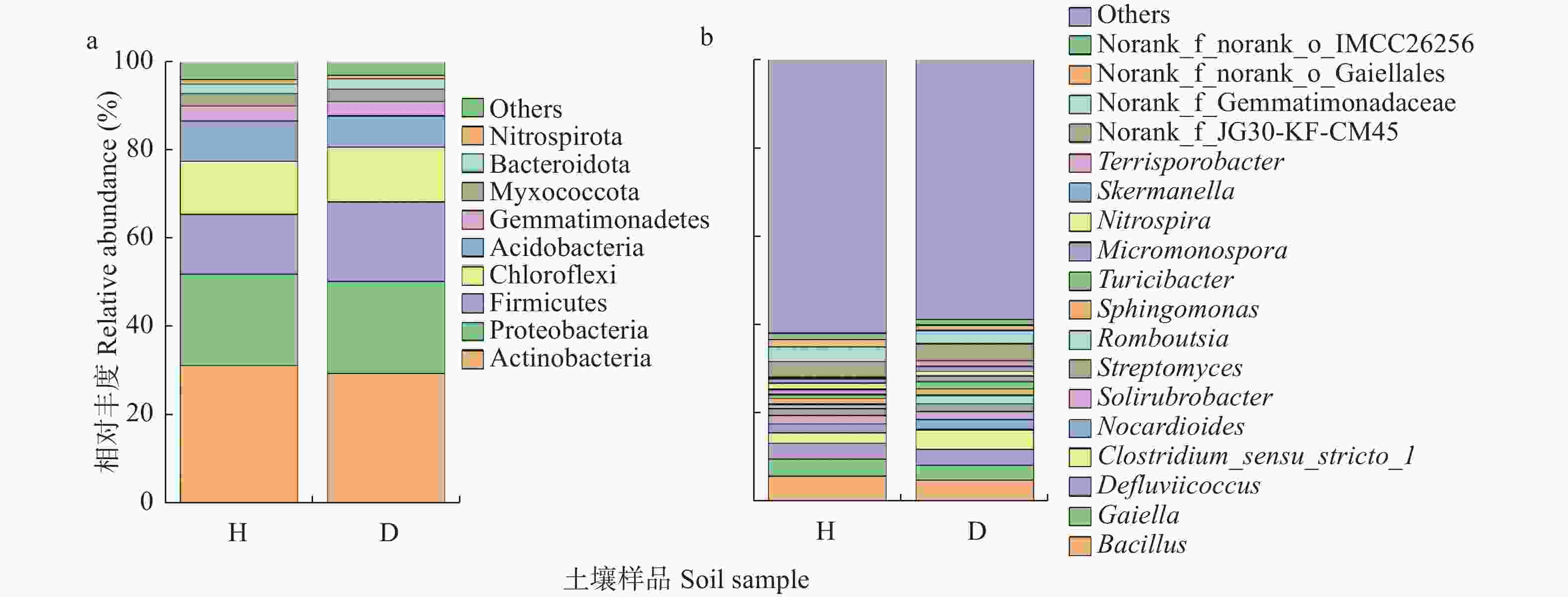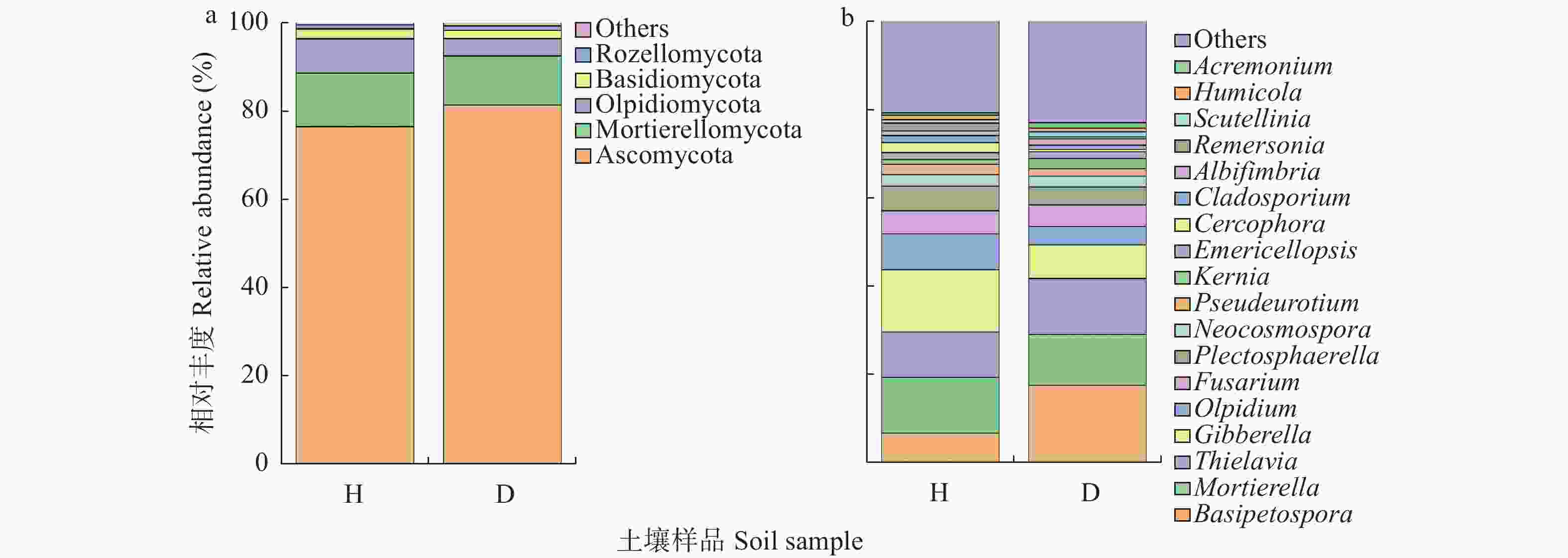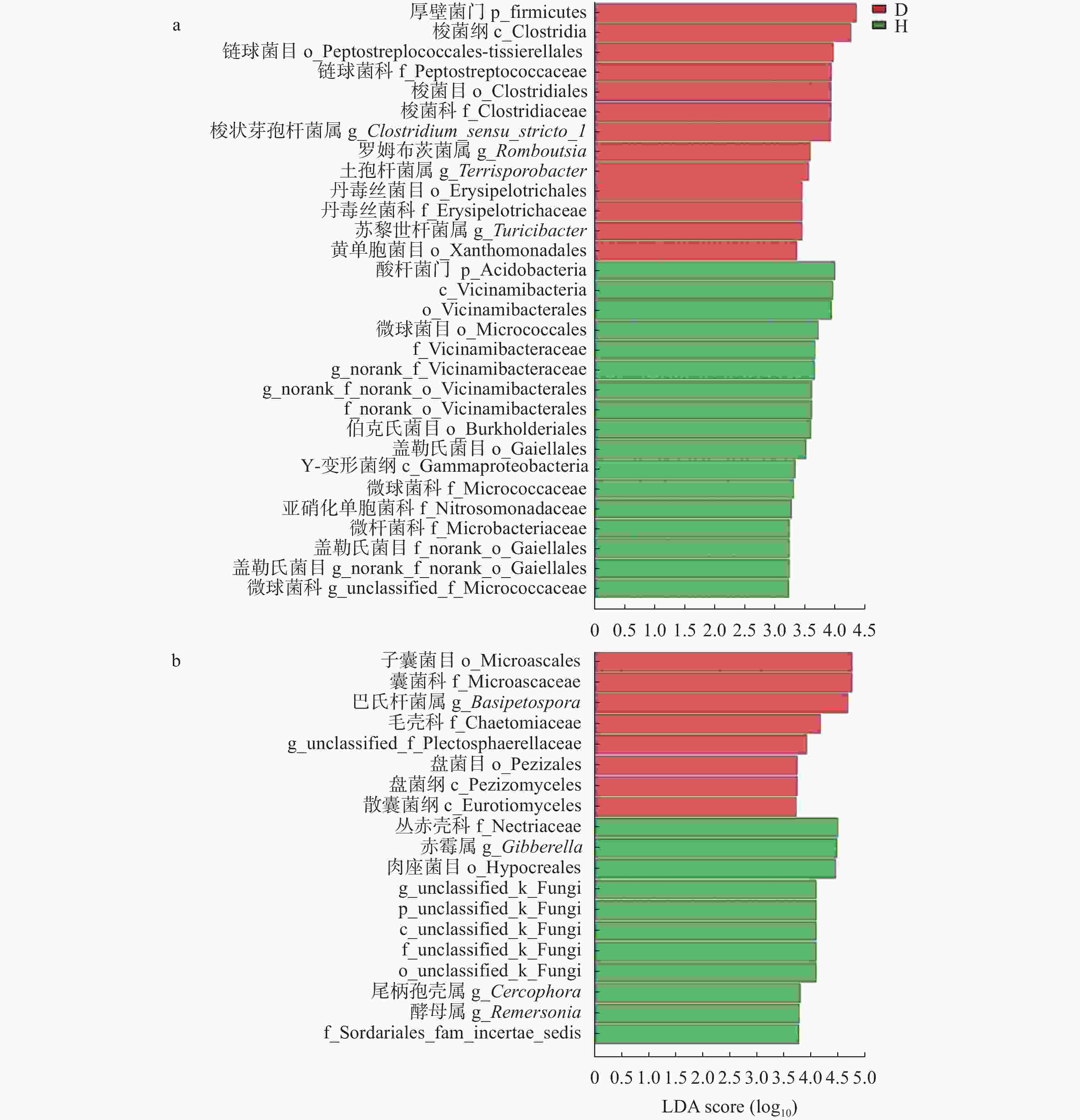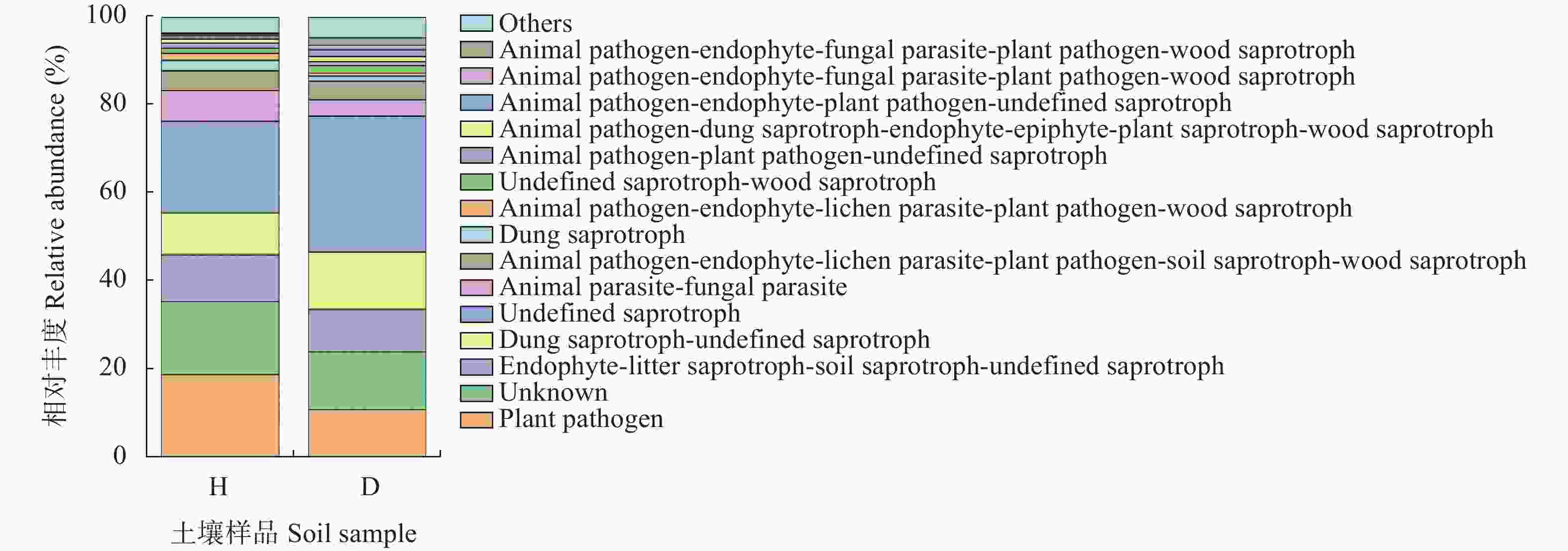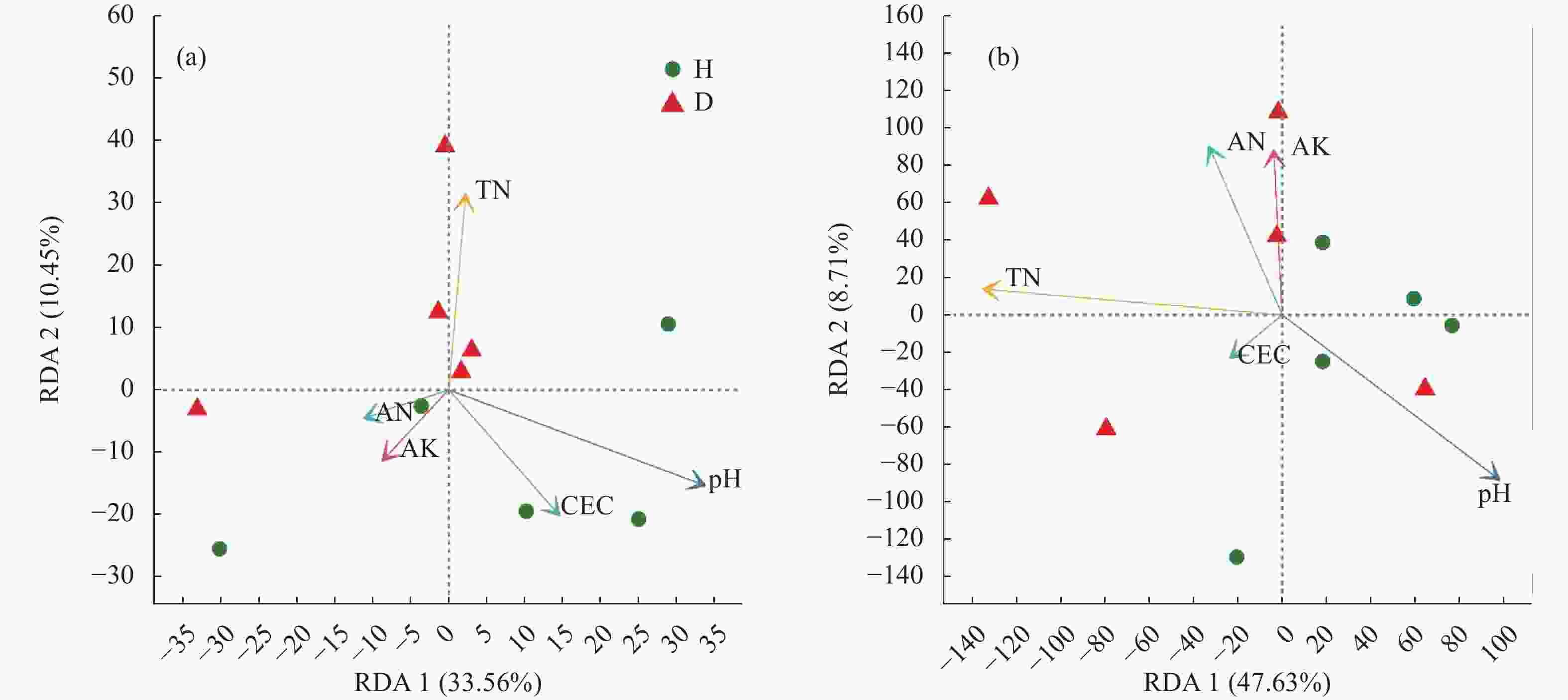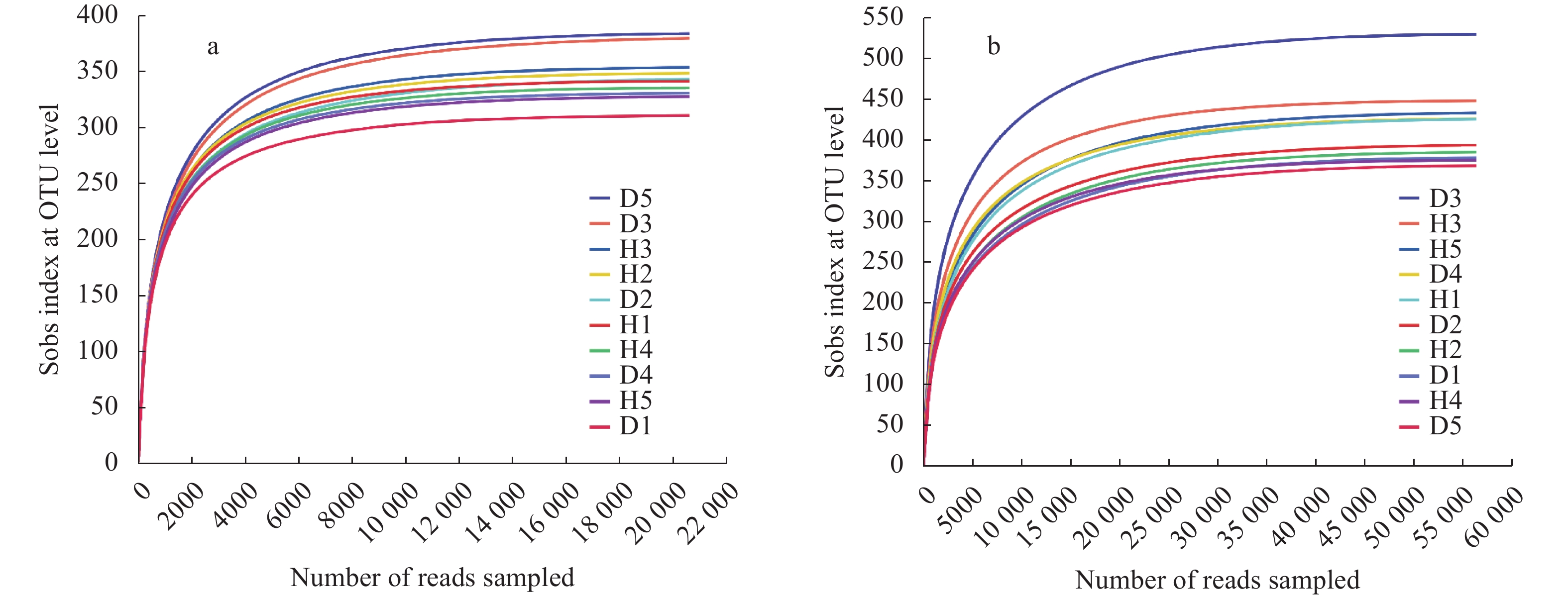Differences in soil microbial community and function between healthy and clubroot diseased plants of Chinese cabbage
-
摘要: 根肿病严重制约着十字花科蔬菜产业的发展, 而土壤微生物多样性与组成的变化不仅与十字花科作物根肿病密切相关, 且对土壤健康、农业生产系统的可持续发展和人体健康至关重要。因此, 了解十字花科根肿病发生与土壤微生物群落结构的关系十分必要。采用Illumina MiSeq高通量测序技术对白菜健康株和患根肿病病株的根围土壤的细菌16S rDNA和真菌ITS序列进行测序, 将结果质控后与相关数据库进行比对; 测定了根围土壤理化性质, 分析了样本间的微生物群落结构与组成差异, 探讨土壤理化、土壤微生物群落和根肿病间的关系; 并对样本细菌和真菌功能进行了预测。结果表明: 1)健康白菜植株根围土壤细菌群落均匀度及多样性程度均高于患根肿病植株, 患根肿病白菜植株根围土壤真菌群落丰富度、均匀性和多样性程度均高于健康白菜植株根围土壤。2)放线菌门(Actinobacteria)、变形菌门(Proteobacteria)、厚壁菌门(Firmicutes)、绿弯菌门(Chloroflexi)、酸杆菌门(Acidobacteria)和芽单胞菌门(Gemmatimonadetes)是所测土壤样本中的主要优势细菌门, 芽孢杆菌属(Bacillus)、Gaiella、Defluviicoccus、梭状芽孢杆菌属(Clostridium)和类诺卡氏属(Nocardioides)是所测土壤样本中的主要优势细菌属; 根围土壤优势真菌类群为子囊菌门(Ascomycota)、被孢霉门(Mortierellomycota)、担子菌门(Basidiomycota)和壶菌门(Olpidiomycota), 主要的真菌属为赤霉属(Gibberella)、被孢霉属(Mortierella)、梭孢壳属(Thielavia)和Basipetospora。3)新陈代谢、环境信息处理、细胞过程和有机系统是健康株与患病株根围土壤细菌群落具有显著差异的4类细菌功能; 患根肿病植株根围土壤真菌群落中赤霉属、梭孢壳属、丝壳属(Kernia)和镰刀菌属(Fusarium)的功能丰度均大于健康株。4)主坐标分析结果表明健康植株与患根肿病植株根围土壤细菌和真菌群落结构差异明显, 冗余分析结果显示pH、全氮、碱解氮、速效钾和阳离子交换量是根围土壤微生物群落变化的主要影响因素。白菜健康株与根肿病患病株根围土壤中真菌群落的差异比细菌群落大。本文为研究十字花科作物微生物区系提供了新的依据, 并为研究有益合成菌群抑制病原菌从而控制根肿病的方法提供了可能性, 同时也为缓解土壤退化和重建健康土壤提供了途径。Abstract: Clubroot disease severely restricts the development of the cruciferous vegetables industry. Changes in soil microbial diversity and composition are not only closely related to cruciferous crop clubroot disease but are also crucial to soil health, sustainable development of agricultural production systems, and human health. Therefore, it is necessary to understand the differences in microbial community structure between clubroot and bulk soil. Illumina MiSeq high-throughput sequencing technology was used to sequence bacterial 16S rDNA and fungal ITS genes in the bulk soil of healthy (H) and clubroot infected (D) Chinese cabbage. The results were compared with relevant databases after quality control. The physical and chemical properties of the bulk soil were determined, and the differences in the microbial community structure and composition between samples were analyzed. The relationship between soil physical and chemical properties, soil microbial community, and clubroot disease was discussed, and the function of bacteria and fungi in the samples was predicted. The results showed that: 1) the evenness and diversity of the bacterial community in the bulk soil of healthy Chinese cabbage plants were higher than those in the bulk soil of healthy Chinese cabbage plants. The richness, evenness, and diversity of fungal communities in the bulk soil of Chinese cabbage plants with clubroot disease was higher than those in the bulk soil of healthy Chinese cabbage plants, indicating that clubroot disease greatly influenced the composition of the soil fungal community. 2) Actinobacteria, Proteobacteria, Firmicutes, Chloroflexi, Acidobacteria, and Gemmatimonadetes were the dominant phyla of bacteria in soil samples. Bacillus, Gaiella, Defluviicoccus, Clostridium, and Nocardioides were the dominant genera of bacteria in the soil samples. The dominant fungal phyla in the bulk soil were Ascomycota, Mortierellomycota, Basidiomycota, and Olpidiomycota. The main fungal genera identified were Gibberella, Mortierella, Thielavia, and Basipetospora. 3) Metabolism, environmental information processing, cellular processes, and organic systems are four types of bacterial functions with significant differences in bulk soil bacterial communities between healthy and diseased plants;the functional abundances of Gibberella, Thielavia, Kernia, and Fusarium in bulk soil fungal communities of diseased plants were higher than those of healthy plants. 4) Principal coordinate analysis showed that the bacterial and fungal community structures in the bulk soil of healthy and diseased plants were significantly different. Redundant analysis showed that pH, total nitrogen, available nitrogen, available potassium, and cation exchange capacity were the main factors influencing microbial community changes in bulk soil. This study provides a new basis for the study of rhizosphere microbial flora of cruciferous crops and provides the possibility for the study of the method of controlling clubroot by beneficial synthetic bacteria-mediated pathogenic bacteria, as well as a way to alleviate soil degradation and rebuild healthy soil.
-
图 1 健康与患根肿病白菜植株根围土壤细菌(a)和真菌(b)稀疏曲线
H1、H2、H3、H4、H5为健康白菜植株根围土壤样品, D1、D2、D3、D4、D5为患根肿病白菜植株根围土壤样品。H1, H2, H3, H4 and H5 are bulk soil samples of healthy Chinese cabbage plants; D1, D2, D3, D4 and D5 are bulk soil samples of Chinese cabbage plants with clubroot disease.
Figure 1. Bulk soil bacterial (a) and fungal (b) rarefaction curves for the healthy and clubroot infected Chinese cabbage
图 2 健康(H)与患根肿病(D)白菜植株根围土壤细菌(a)和真菌(b)维恩图
韦恩图显示健康和患病根围土壤间共有和特有的操作分类单元的数量(相似性≥97%)。Venn diagram shows the number of shared and unique operational taxonomic units among the bulk soils of healthy and diseased plants (≥97% similarity).
Figure 2. Venn diagram for bacterial (a) and fungal (b) communities in the bulk soil of healthy (H) and clubroot infected (D) Chinese cabbage plants
图 3 健康(H)与患根肿病(D)白菜植株根围土壤细菌(a)和真菌(b)主坐标分析
●: 健康白菜植株根围土壤; ▲: 患根肿病白菜植株根围土壤。●: bulk soil of healthy Chinese cabbage plant; ▲: bulk soil of Chinese cabbage plants with clubroot disease.
Figure 3. Principal coordinate analyses (PCoA) for bacteria (a) and fungi (b) in the bulk soil of healthy (H) and clubroot infected (D) Chinese cabbage plants
图 6 健康(H)与患根肿病(D)白菜植株根围土壤细菌(a)和真菌(b)属水平的LDA判别结果图
纵坐标中小写字母c、o、f、g为分类水平, 分别代表纲、目、科和属水平。The lowercase letters c, o, f, and g in the vertical coordinate represent the classification level, representing the class, order, family and genus levels, respectively.
Figure 6. LDA discriminant result charts for genus level of bacteria (a) and fungi (b) in the bulk soil of healthy (H) and clubroot infected (D) Chinese cabbage plants
图 9 经VIF筛选后的土壤理化因子与健康(H)与患根肿病(D)白菜植株根围土壤细菌(a)和真菌(b)群落冗余分析
TN: 全氮; AN: 碱解氮; AK: 速效钾; CEC: 阳离子交换量。TN: total nitrogen; AN: available nitrogen; AK: available potassium; CEC: cation exchange capacity.
Figure 9. Redundancy analysis on bacteria (a) and fungi (b) communities by properties of the bulk soil of healthy (H) and clubroot infected (D) Chinese cabbage plants after screening by variance inflation factor test
表 1 健康与患根肿病白菜植株根围土壤理化性质
Table 1. Physicochemical properties of bulk soil of healthy and clubroot infected Chinese cabbage plants
土壤样品
Soil samplepH 有机质
Soil organic matter
(g∙kg−1)全氮
Total
nitrogen
(g∙kg−1)碱解氮
Alkaline
nitrogen
(mg∙kg−1)速效磷
Available phosphorus
(mg∙kg−1)速效钾
Available
potassium
(mg∙kg−1)交换性钙
Exchangeable calcium
(mg∙kg−1)交换性镁
Exchangeable magnesium
(mg∙kg−1)阳离子交换量
Cation exchange capacity
(cmol∙kg−1)健康株
Healthy plant7.49±0.12a 46.46±1.50a 1.86±0.13a 232±12.48a 146±4.68a 753±81.77a 13 054±179.50a 466±5.10a 35.23±0.16a 患病株
Diseased plant7.05±1.23a 38.98±4.64a 1.88±0.17a 190±29.51a 105±13.56a 603±106.50a 10 935±189.32b 435±2.37b 29.38±2.30a 同列中不同小写字母表示差异显著(P<0.05)。Different lowercase letters in the same column indicate significant difference (P<0.05). 表 2 健康与患根肿病白菜植株根围土壤不同分类水平微生物群落数
Table 2. Number of microbial communities at different classification levels in the bulk soil of healthy and clubroot infected Chinese cabbage plants
土壤样品 Soil sample 门 Phylum 纲 Class 目 Order 科 Family 属 Genus 种 Species 操作分类单元 OTU 真菌 Fungi 健康株 Healthy plant 13 46 96 200 413 708 3329 患病株 Diseased plant 14 46 100 212 429 729 3197 细菌 Bacteria 健康株 Healthy plant 36 122 274 425 812 1526 5840 患病株 Diseased plant 38 127 288 454 884 1697 6421 表 3 健康与患根肿病白菜植株根围土壤微生物群落Alpha多样性指数
Table 3. Alpha diversity indices of bulk soil microbial communities of the healthy and clubroot infected Chinese cabbage plants
土壤样品
Soil sample丰富度指数
Richness index均匀度指数
Evenness index多样性指数
Diversity index覆盖度指数
Coverage indexSobs Chao 1 Shannon Simpson Shannon Simpson Coverage 真菌
Fungi健康株 Healthy plant 411.84±14.77a 412.20±14.76a 0.639±0.01a 0.051±0.004a 3.84±0.10a 0.066±0.01a 1.000±0.000a 患病株 Diseased plant 417.64±13.34a 417.96±13.33a 0.640±0.01a 0.046±0.003a 3.86±0.08a 0.063±0.01a 1.000±0.000a 细菌
Bacteria健康株 Healthy plant 1015.84±24.64a 1018.24±24.97a 0.936±0.001a 0.43±0.01a 6.47±0.02a 0.002±0.000b 1.000±0.000a 患病株 Diseased plant 1011.28±16.40a 1011.91±16.50a 0.930±0.001b 0.38±0.007b 6.43±0.02a 0.003±0.000a 0.999±0.000b 不同小写字母表示健康株与患病株之间差异显著(P<0.05)。Different letters mean significant difference between healthy and diseased plants at P<0.05 level. 表 4 土壤理化因子与细菌和真菌群落结构的相关性分析
Table 4. Correlation analysis between the bacterial and fungal community structures with the different soil physical and chemical factors
微生物群落
Microbial communitypH 全氮
Total nitrogen碱解氮
Available nitrogen速效钾
Availalbe potassium阳离子交换量
Cation exchange capacity细菌群落 Bacteria community 0.5929* 0.4632* 0.4026 0.2772 0.2550 真菌群落 Fungal community 0.5349* 0.3475 0.4720* 0.5585* 0.2398 -
[1] 吴克宁, 杨淇钧, 赵瑞. 耕地土壤健康及其评价探讨[J]. 土壤学报, 2021, 58(3): 537−544 doi: 10.11766/trxb202009280546WU K N, YANG Q J, ZHAO R. A discussion on soil health assessment of arable land in China[J]. Acta Pedologica Sinica, 2021, 58(3): 537−544 doi: 10.11766/trxb202009280546 [2] HAN X Y. Plasmodiophora brassicae in Yunnan and its resistant sources in Chinese cabbage[J]. International Journal of Agriculture and Biology, 2021, 25(4): 805−812 doi: 10.17957/IJAB/15.1732 [3] WEI X M, WANG X Y, CAO P, et al. Microbial community changes in the rhizosphere soil of healthy and rusty Panax ginseng and discovery of pivotal fungal genera associated with rusty roots[J]. BioMed Research International, 2020, 2020: 8018525 [4] LEBRETON L, GUILLERM-ERCKELBOUDT A Y, GAZENGEL K, et al. Temporal dynamics of bacterial and fungal communities during the infection of Brassica rapa roots by the protist Plasmodiophora brassicae[J]. PLoS One, 2019, 14(2): e0204195 doi: 10.1371/journal.pone.0204195 [5] LIU C M, YANG Z F, HE P F, et al. Deciphering the bacterial and fungal communities in clubroot-affected cabbage rhizosphere treated with Bacillussubtilis XF-1[J]. Agriculture, Ecosystems & Environment, 2018, 256: 12−22 [6] FU L N, LI H M, WEI L F, et al. Antifungal and biocontrol evaluation of four Lysobacter strains against clubroot disease[J]. Indian Journal of Microbiology, 2018, 58(3): 353−359 doi: 10.1007/s12088-018-0716-2 [7] AHMED A, MUNIR S, HE P F, et al. Biocontrol arsenals of bacterial endophyte: an imminent triumph against clubroot disease[J]. Microbiological Research, 2020, 241: 126565 doi: 10.1016/j.micres.2020.126565 [8] YANG X X, HUANG X Q, WU W X, et al. Effects of different rotation patterns on the occurrence of clubroot disease and diversity of rhizosphere microbes[J]. Journal of Integrative Agriculture, 2020, 19(9): 2265−2273 doi: 10.1016/S2095-3119(20)63186-0 [9] STRUCK C, RÜSCH S, STREHLOW B. Control strategies of clubroot disease caused by Plasmodiophora brassicae[J]. Microogganismes, 2022, 10: 620 doi: 10.3390/microorganisms10030620 [10] 朱永官, 彭静静, 韦中, 等. 土壤微生物组与土壤健康[J]. 中国科学:生命科学, 2021, 51(1): 1−11ZHU Y G, PENG J J, WEI Z, et al. Linking the soil microbiome to soil health[J]. Scientia Sinica (Vitae), 2021, 51(1): 1−11 [11] 张俊伶, 张江周, 申建波, 等. 土壤健康与农业绿色发展: 机遇与对策[J]. 土壤学报, 2020, 57(4): 783−796ZHANG J L, ZHANG J Z, SHEN J B, et al. Soil health and agriculture green development: opportunities and challenges[J]. Acta Pedologica Sinica, 2020, 57(4): 783−796 [12] ZHOU D B, JING T, CHEN Y F, et al. Deciphering microbial diversity associated with Fusarium wilt-diseased and disease-free banana rhizosphere soil[J]. BMC Microbiology, 2019, 19(1): 161 doi: 10.1186/s12866-019-1531-6 [13] QI G F, MA G Q, CHEN S, et al. Microbial network and soil properties are changed in bacterial wilt-susceptible soil[J]. Applied and Environmental Microbiology, 2019, 85(13): e00162−e00119 [14] 鲍士旦. 土壤农化分析[M]. 3版. 北京: 中国农业出版社, 2000BAO S D. Soil and Agricultural Chemistry Analysis[M]. Beijing: China Agriculture Press, 2000 [15] YUAN J, WEN T, ZHANG H, et al. Predicting disease occurrence with high accuracy based on soil macroecological patterns of Fusarium wilt[J]. The ISME Journal, 2020, 14(12): 2936−2950 doi: 10.1038/s41396-020-0720-5 [16] 孙战, 王圣洁, 杨锦昌, 等. 木麻黄根区土壤理化特性及酶活性与青枯病发生关联分析[J]. 生态环境学报, 2022, 31(1): 70−78SUN Z, WANG S J, YANG J C, et al. Correlation analysis of the occurrence of bacterial wilt and physicochemical properties and enzyme activity of root-zone soil of Casuarina spp.[J]. Ecology and Environmental Sciences, 2022, 31(1): 70−78 [17] PEI W H, LI X D, YANG P W, et al. Study on pathogenicity difference of Plasmodiophora brassicae under different temperature and pH conditions[J]. Agricultural Science & Technology, 2015, 16(1): 112−115 [18] KNOX O, OGHORO C O, BURNETT F, et al. Biochar increases soil pH, but is as ineffective as liming at controlling clubroot[J]. Journal of Plant Pathology, 2015, 97: 149−152 [19] BOTERO-RAMIREZ A, HWANG S F, STRELKOV S E. Plasmodiophora brassicae inoculum density and spatial patterns at the field level and relation to soil characteristics[J]. Pathogens, 2021, 10(5): 499 doi: 10.3390/pathogens10050499 [20] 闫玉芳, 蒋欢, 董代文, 等. 感染根肿病的茎瘤芥土壤氮磷钾及有机质含量分析[J]. 西南农业学报, 2018, 31(9): 1825−1828 doi: 10.16213/j.cnki.scjas.2018.9.011YAN Y F, JIANG H, DONG D W, et al. Study on content of nitrogen, phosphorus, potassium and organic matter in Brassica juncea var. tumida Tsen et Lee soil infected by clubroot[J]. Southwest China Journal of Agricultural Sciences, 2018, 31(9): 1825−1828 doi: 10.16213/j.cnki.scjas.2018.9.011 [21] 班洁静. 土壤含水量、pH、Ca2+浓度对芸薹根肿菌侵染及发病影响研究[D]. 武汉: 华中农业大学, 2014BAN J J. The influence of soil moisture content, pH, Ca2+ concentration to Plasmodiophora brassicae infection and disease occur[D]. Wuhan: Huazhong Agricultural University, 2014 [22] HIRT H. Healthy soils for healthy plants for healthy humans: How beneficial microbes in the soil, food and gut are interconnected and how agriculture can contribute to human health[J]. EMBO Reports, 2020, 21(8): e51069 [23] FIERER N, WOOD S, DE MESQUITA C P B. How microbes can, and cannot, be used to assess soil health[J]. Soil Biology and Biochemistry, 2020. https://doi.org/10.32942/osf.io/t9d5y [24] 伍文宪, 黄小琴, 张蕾, 等. 十字花科作物根肿病对根际土壤微生物群落的影响[J]. 生态学报, 2020, 40(5): 1532−1541WU W X, HUANG X Q, ZHANG L, et al. Crucifer clubroot disease changes the microbial community structure of rhizosphere soil[J]. Acta Ecologica Sinica, 2020, 40(5): 1532−1541 [25] TIAN X, WANG D D, MAO Z, et al. Infection of Plasmodiophora brassicae changes the fungal endophyte community of tumourous stem mustard roots as revealed by high-throughput sequencing and culture-dependent methods[J]. PLos One, 2019, 14(6): e0214975 doi: 10.1371/journal.pone.0214975 [26] 张丽娟, 曲继松, 郭文忠, 等. 微生物菌肥对黄河上游地区设施土壤微生物及酶活性的影响[J]. 中国土壤与肥料, 2014(5): 32−36,99 doi: 10.11838/sfsc.20140507ZHANG L J, QU J S, GUO W Z, et al. Effects of the microbial fertilizers on microorganism and enzymic activity in greenhouse soil on upper reaches of the Yellow River[J]. Soil and Fertilizer Sciences in China, 2014(5): 32−36,99 doi: 10.11838/sfsc.20140507 [27] 刘海洋, 姚举, 张仁福, 等. 黄萎病不同发生程度棉田中土壤微生物多样性[J]. 生态学报, 2018, 38(5): 1619−1629LIU H Y, YAO J, ZHANG R F, et al. Analysis of soil microbial diversity in cotton fields differing in occurrence of cotton Verticillium wilt in Xinjiang[J]. Acta Ecologica Sinica, 2018, 38(5): 1619−1629 [28] ZHANG Y P, LI W, LU P, et al. Three preceding crops increased the yield of and inhibited clubroot disease in continuously monocropped Chinese cabbage by regulating the soil properties and rhizosphere microbial community[J]. Microorganisms, 2022, 10(4): 799 doi: 10.3390/microorganisms10040799 [29] SARAIVA A, BHERING A, CARMO M, et al. Bacterial composition in brassica‐cultivated soils with low and high severity of clubroot[J]. Journal of Phytopathology, 2020, 168: 11−12 [30] HU Y L, QIU L, ZHANG Z J, et al. Control of Streptomyces alfalfae XY25T over clubroot disease and its effect on rhizosphere microbial community in Chinese cabbage field trials[J]. Frontiers in Microbiology, 2021, 12: 641556 doi: 10.3389/fmicb.2021.641556 [31] WANG T T, HAO Y W, ZHU M Z, et al. Characterizing differences in microbial community composition and function between Fusarium wilt diseased and healthy soils under watermelon cultivation[J]. Plant and Soil, 2019, 438(1/2): 421−433 [32] WANG D D, SUN T T, ZHAO S Y, et al. Physiological change alters endophytic bacterial community in clubroot of tumorous stem mustard infected by Plasmodiophora brassicae[J]. BMC Microbiology, 2020, 20: 224 doi: 10.1186/s12866-020-01909-1 [33] 杨盼, 翟亚萍, 赵祥, 等. 丛枝菌根真菌和根瘤菌互作对苜蓿根际土壤细菌群落结构的影响及PICRUSt功能预测分析[J]. 微生物学通报, 2020, 47(11): 3868−3879 doi: 10.13344/j.microbiol.china.190978YANG P, ZHAI Y P, ZHAO X, et al. Effect of interaction between arbuscular mycorrhizal fungi and rhizobium on Medicago sativa rhizosphere soil bacterial community structure and PICRUSt functional prediction[J]. Microbiology China, 2020, 47(11): 3868−3879 doi: 10.13344/j.microbiol.china.190978 [34] LIU H L, QI Y Q, WANG J H, et al. Synergistic effects of crop residue and microbial inoculant on soil properties and soil disease resistance in a Chinese Mollisol[J]. Scientific Reports, 2021, 11: 24225 doi: 10.1038/s41598-021-03799-3 [35] HARTWRIGHT L M, HUNTER P J, WALSH J A. A comparison of Olpidium isolates from a range of host plants using internal transcribed spacer sequence analysis and host range studies[J]. Fungal Biology, 2010, 114(1): 26−33 doi: 10.1016/j.mycres.2009.09.008 [36] CHO G, KWAK Y S. Genetic variation of strawberry Fusarium wilt pathogen population in Korea[J]. Mycobiology, 2022, 50: 82−88 [37] 付彦祥, 李乃荟, 刘佳遥, 等. 伴生分蘖洋葱对番茄根际微生物群落结构的影响[J]. 中国蔬菜, 2020(6): 49−57FU Y X, LI N H, LIU J Y, et al. Effects of concomitant tillering onion on microbial community structure in tomato rhizosphere soil[J]. China Vegetables, 2020(6): 49−57 [38] PALMER J S, HOUGH R, WEST H, et al. A review of the abundance, behaviour and detection of clostridial pathogens in agricultural soils[J]. European Journal of Soil Science, 2019, 70: 911−929 doi: 10.1111/ejss.12847 [39] WANG X H, JI C, SONG X, et al. Biocontrol of two bacterial inoculant strains and their effects on the rhizosphere microbial community of field-grown wheat[J]. BioMed Research International, 2021. https://doi.org/10.1155/2021/8835275 -





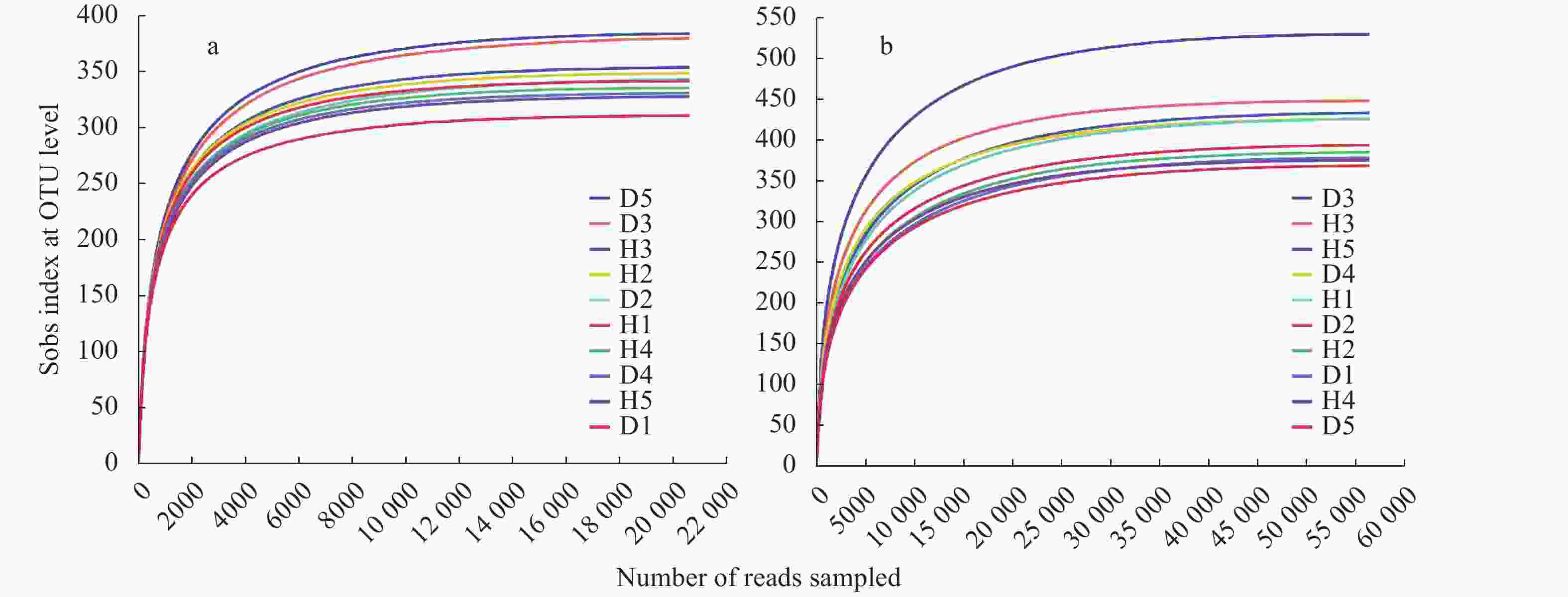
 下载:
下载:

